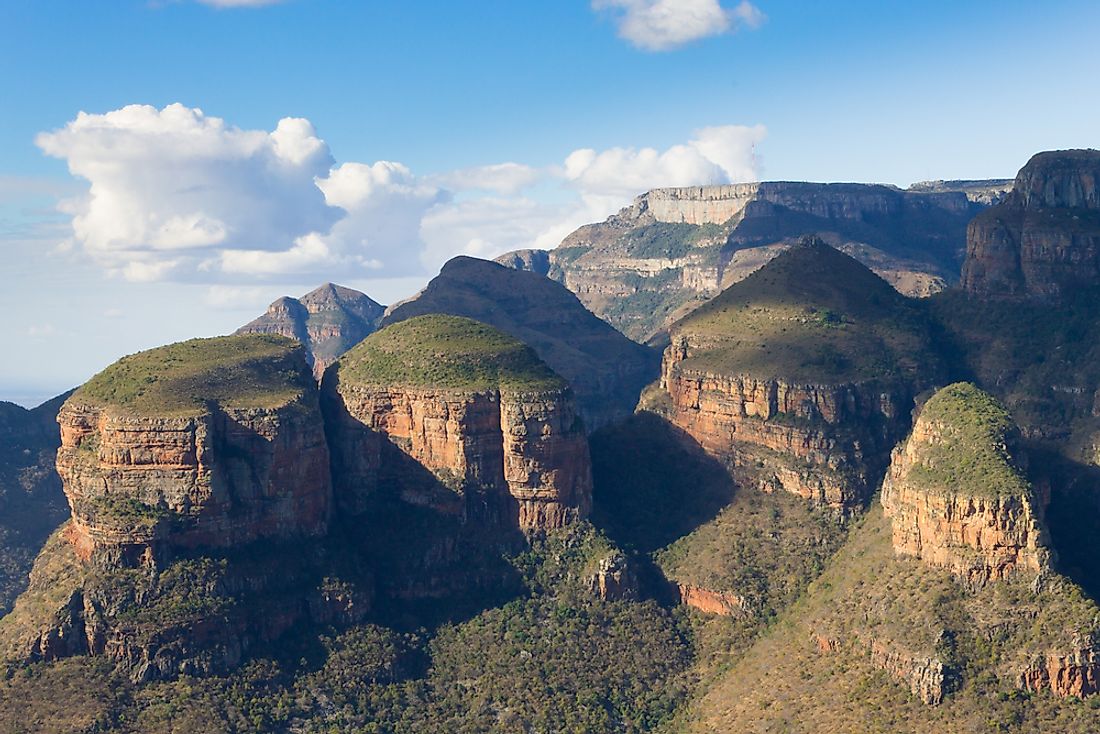The Three Rondavels - Unique Landforms of Asia

The Three Rondavels (sometimes referred to as the Three Sisters) refer to a timeworn geological marvel that lies in the Blyde River Canyon Nature Reserve in South Africa. The nature reserve is located in the Drakenserg escarpment of South Africa. The Three Rondavels are a group of three round and almost pointed mountain tops that are covered up by grass. The peaks resemble the traditional rondavels (hut shaped structures) which were constructed using local materials such as mud, grass, and trees. The Three Rondavels should not be confused with a similar feature which is located in the Northern Cape.
Sometimes, the marvel may be called the “Chiefs’ Troublesome Wives” or “The Chief and Three Wives” in remembrance of Chief Maripi who lived in the 19th century together with his three wives. Next to the Three Rondavels is a peak with a flat top. The peak with the flattened top is said to represent the chief who was known as Mapjaneng and was responsible for rebuffing attacks from Swazis. His three most troublesome wives, Magabolle, Maseroto, and Mogoladikwe, are represented by the peaks of the Three Rondavels. The Three Rondavels offer a magnificent view of South Africa’s Mariepskop Plateau. Nearby, there is also the Thabaneng Hill which is a mountain whose shadow is said to depict the time.
Formation
The formation of this geological wonder is quite simple. The area is made up of sedimentary rocks which lie in layers on top of one another. Over time, extensive and unrelenting erosion of the softer and less resistant top layers left the tougher and more resistant layers exposed. These tougher and more resilient rocks are the shale and quartz rocks that form the rondavels today. The Three Rondavels stand at a breathtaking 2,296 feet above the environs.
Habitat
The entire region of the Blyde River Canyon is home to several species of flora and fauna. Derived from a Dutch word that represents happiness, the canyon may also be known as the Happy River Canyon. Higher plateaus are occupied by several animals such as baboons while species such as hippos and crocodiles inhabit the lowlands. In addition, there are several species of fish such as trout and bass in the rivers within the reserve. Several bird species such as the African fish eagle also call the reserve home.
The vegetation in the region is equally diverse. The high variations in temperature, pedology, geology, and altitude are to be given credit for the diversity in the flora. Within the canyon, there are over 1,000 species of plants that have been discovered including orchids, cycads, and hundreds more. Native forests cover about 7.3% of the total area.
Tourism
Alongside other features in the canyon such as God’s Window, Lisbon Falls, Bourke's Luck Potholes, and several others, the site is a popular tourist destination for visitors from all over the globe. The Three Rondavels are open for visitation all around the year although the majority of visitors go between October and March when the conditions are drier. The reserve is well maintained and easily accessible by road.











